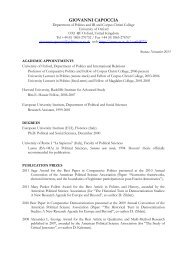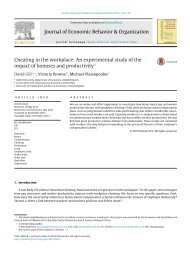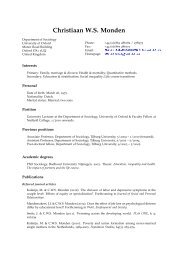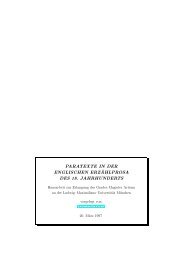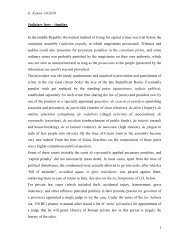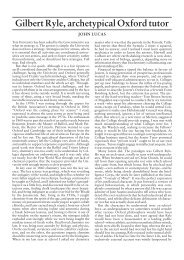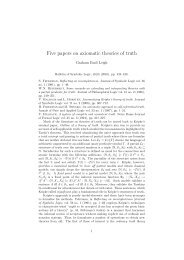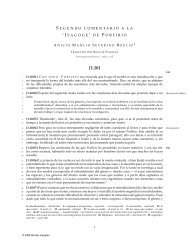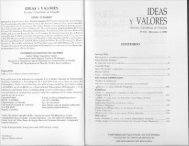Lexical Functional Grammar - Personal Pages Index
Lexical Functional Grammar - Personal Pages Index
Lexical Functional Grammar - Personal Pages Index
You also want an ePaper? Increase the reach of your titles
YUMPU automatically turns print PDFs into web optimized ePapers that Google loves.
(1) David is sleeping.<br />
IP<br />
NP<br />
I ′<br />
N ′<br />
I<br />
VP<br />
N<br />
David<br />
is<br />
V ′<br />
V<br />
sleeping<br />
C-structure trees contain two sorts of categories. Categories such as N (noun)<br />
and V (verb), familiar from traditional grammatical analysis, are called lexical<br />
categories. MostLFGanalyses assumeat least thelexical categories N(noun),<br />
A (adjective), V (verb), Adv (adverb), and P (preposition), though more or<br />
fewer categories may be relevant for a particular language. Most languages<br />
also make use of a set of functional categories, including I (for Inflection),<br />
C (for Complementizer), and D (for Determiner). <strong>Functional</strong> categories play<br />
an organizing role in the syntax, and are either associated with closed-class<br />
categories such as complementizers, or are filled with subtypes of particular<br />
lexical categories.<br />
Constituent structure is organized according to X-bar theory (see X-bar<br />
theory), which assumes that phrases are internally headed and therefore endocentric:<br />
a phrase and its head have the same category, but a different bar<br />
level. For example, the basic lexical category N is the head of the single bar<br />
level category N ′ (“N-bar”), which in turn is the head of the two-bar-level category<br />
N ′′ (“N-double-bar”). Similarly, the basic functional category I is the<br />
head of I ′ , which heads I ′′ . Many LFG analyses assume that N ′′ and I ′′ are<br />
maximal phrases, meaning that there is no category N ′′′ or I ′′′ for the doublebar-level<br />
category to head. Thus, as maximal phrases, the categories N ′′ and<br />
I ′′ are usually written as NP (noun phrase) and IP (the category assigned to<br />
a sentence like David is sleeping). Nonprojecting categories are also assumed<br />
(Toivonen, 2003); these are lexical categories that are not heads of phrases, but<br />
appear on their own, adjoined to heads. For example, verbal particles (words<br />
corresponding to the particle up in a sentence like I woke up the baby) in some<br />
Germanic languages are nonprojecting words, typically prepositions, adjoined<br />
to the verb.<br />
Not all phrases are endocentric. LFG assumes a single exocentric, nonheaded<br />
category, the category S, which does not obey the constraints of X-bar<br />
theory. Not all languages make use of this phrase; it plays no role in the syntax<br />
of English, for example. In languages that make use of this phrase, it behaves<br />
as a maximal phrase, but it has no c-structure head, and it can dominate<br />
phrases of any category or bar level. As we will see below, it does not obey<br />
thegeneralizations whichconstrain therelation between endocentricc-structure<br />
categories and f-structure, and so is often motivated in languages with very free<br />
word order, in which morphological information rather than phrase structure<br />
3



